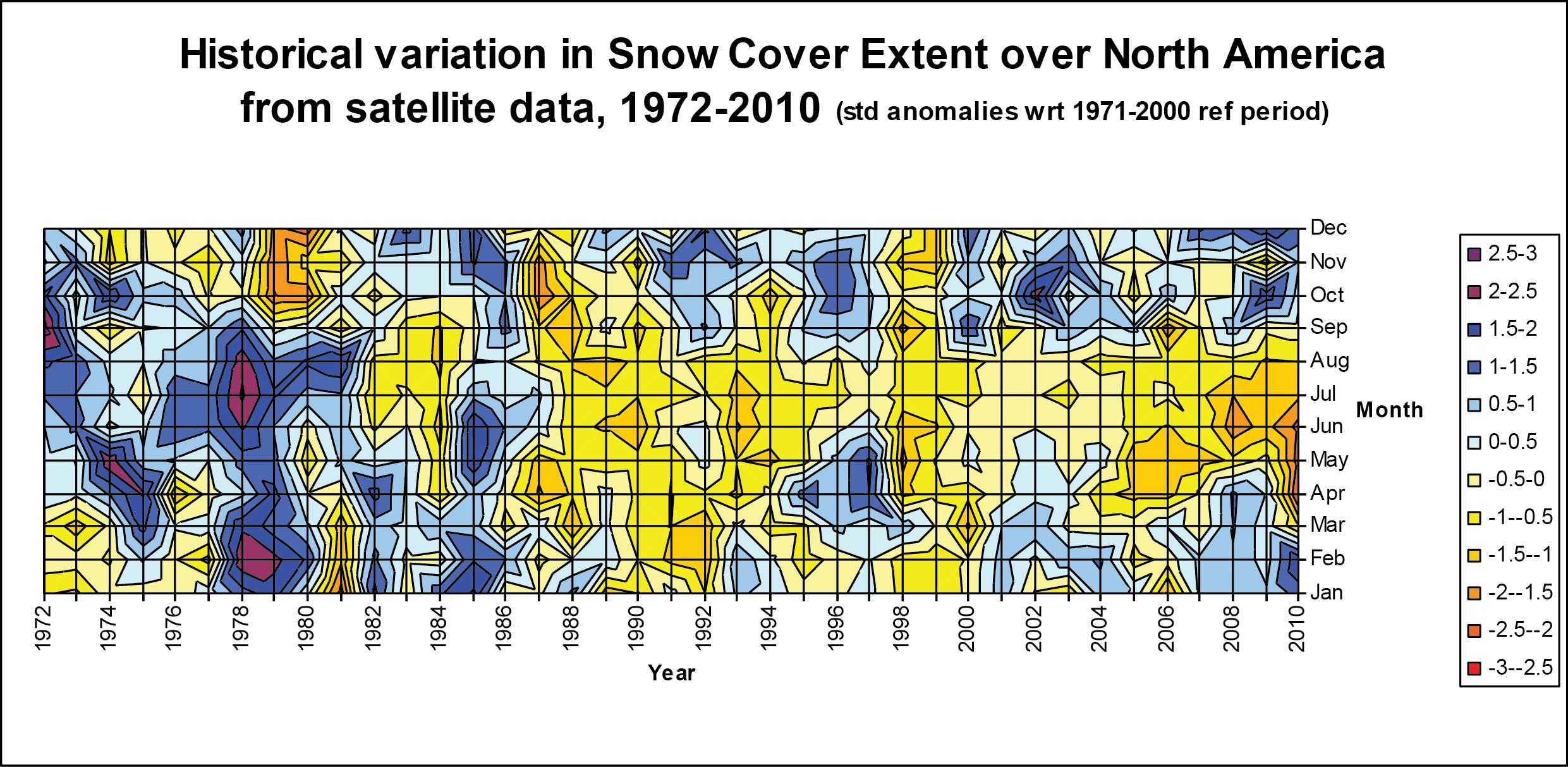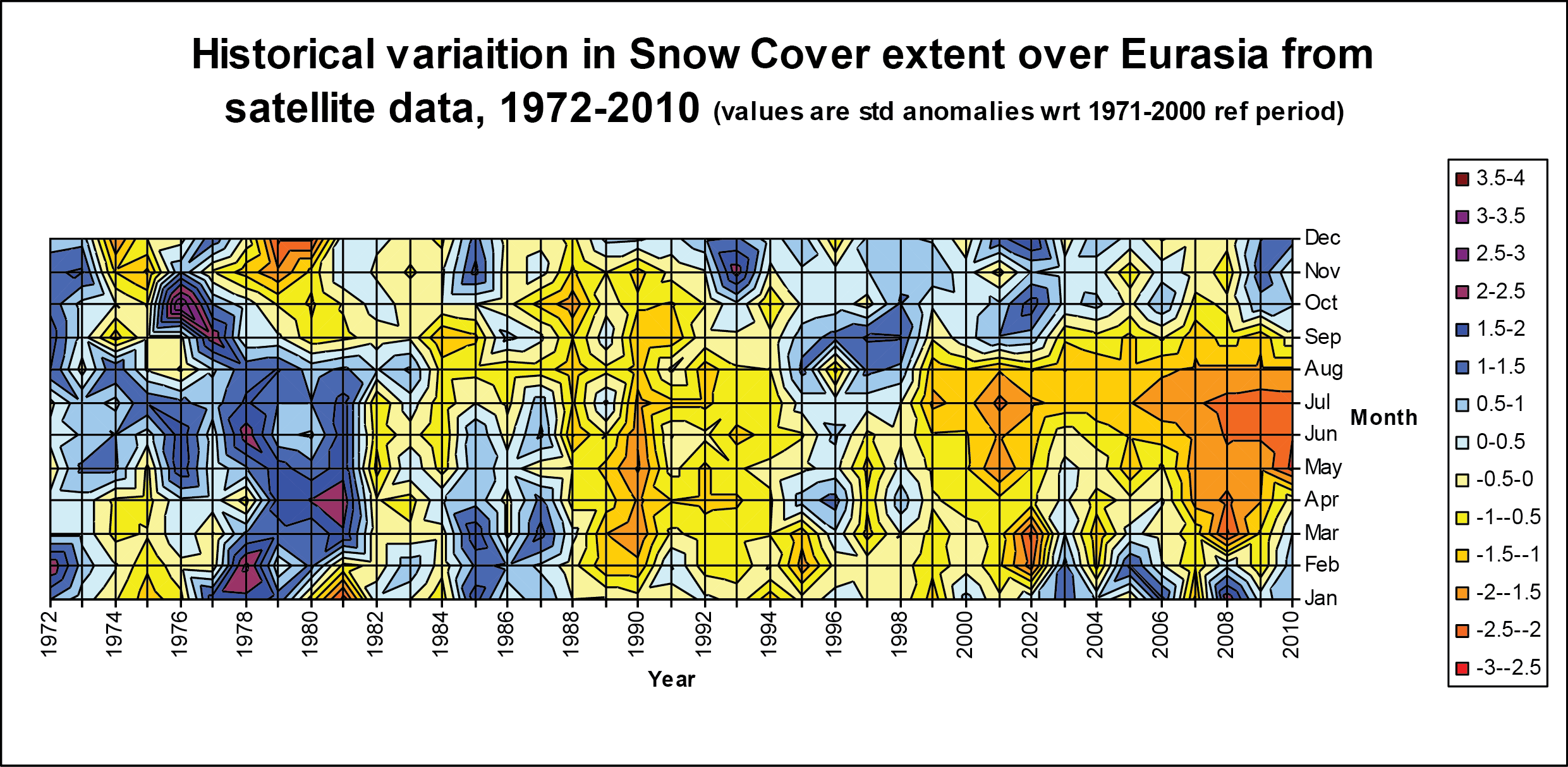Within the last few decades, an overall decrease in snow cover duration has occurred. This temporal decline is most evident as early melt in the spring season across the Arctic, with June snow cover extent decreasing 17.2% per decade since 1979 (Derksen et al., 2015). These decreases in snow duration and extent are variable in the Arctic, with greater changes occurring in coastal regions (Derksen & Brown, 2012) (Kim et al., 2015).
The magnitude of precipitation in the Arctic has seen an upsurge within the last half century, especially during the winter season. Snow cover changes, especially snow depth, are quite variable, with some locations experiencing increasing snow cover but many experiencing decreasing snow cover and increasing rainfall. Refreeze of water on snow creates an ice coating, which can inhibit feeding activities of wildlife (see Ecology section). Although precipitation has increased in all regions of the Arctic, some areas (North Eurasia, parts of North America and Scandinavia) have seen increases in snow cover depth and duration. In these regions, duration of deep snow cover has increased by as much as 10 days per decade. This trend can be attributed to a positive feedback mechanism. As temperatures increase, snow melts, decreasing land albedo, reinforcing further melting (SWIPA, 2011).
Snow cover is additionally influenced by the state of the atmospheric circulation such as North Atlantic Oscillation(NAO). Highly negative NAO states are correlated to reduced snow cover; as was the case in 2012. When NAO is in a negative phase, southern warm air masses are readily translated into the Arctic. This influences the seasonal weather by enhancing snow melt. In contrast, during a positive NAO phase, temperatures are generally lower than average across the Arctic, increasing snow cover (Derksen & Brown, 2012) (NC State University, 2013).
Analysis of Canadian daily snow depth observations since the 1950's (Zhang et al., 2010) reveals that recent decreases in Canadian snow cover have mainly occurred during the spring period, and that the decreases have been strongest over western Canada.
Is this relatively recent trend to lower spring snow cover attributable to global warming? This is the first question most people ask, but it is one that is perhaps the most difficult to answer. Snow cover represents a combined response to precipitation and temperature and exhibits considerable variability from one year to the next as well as over longer time-scales of decades to centuries. Analysis of historical snow cover and corresponding air temperature data clearly show a strong inverse correlation between hemispheric air temperatures and corresponding snow cover extent. This is a reasonable result - everything else being equal, warming will shorten the period of below-freezing temperatures required to generate snowfall and maintain a snow cover.
cover extent expressed as standardized departures
from the monthly average, compared to a 1971-2000
reference period for North America and Eurasia land areas.
Dark blue and purple colors indicate that snow cover was
substantially above-average while orange and red indicate
it was substantially below-average. These data
were obtained from Dr. David Robinson, Rutgers University.
While the evidence indicates that the long-term response of Northern Hemisphere snow cover extent is closely tied to global air temperatures, snow cover extent also responds at continental and regional-scales to changes in atmospheric circulation. For example, Brown and Braaten (1998) showed that the late-20th Century low snow cover conditions observed over many regions of Canada were linked in part to a major shift in atmospheric circulation over the north Pacific and North America that occurred in 1976. Similarly, there is evidence that changes in atmospheric circulation around 1980 involving the North Atlantic Oscillation and Scandinavian pattern have contributed to reductions in March snow cover extent over Eurasia (Brown and Robinson, 2011).
Comparisons between North America and Eurasia show similar patterns for the last four decades: Snow cover was above average up to the early 1980's, followed by decreasing snow cover, especially during the spring-summer period and over Eurasia (Figure 1).
Material for this page was provided by Ross Brown, Climate Processes Section, Climate Research Division, Science and Technology Branch, Environment Canada, Ouranos and edited by edited by Maren Pauly and Tristan Mills, Department of Geography, University of Waterloo.


